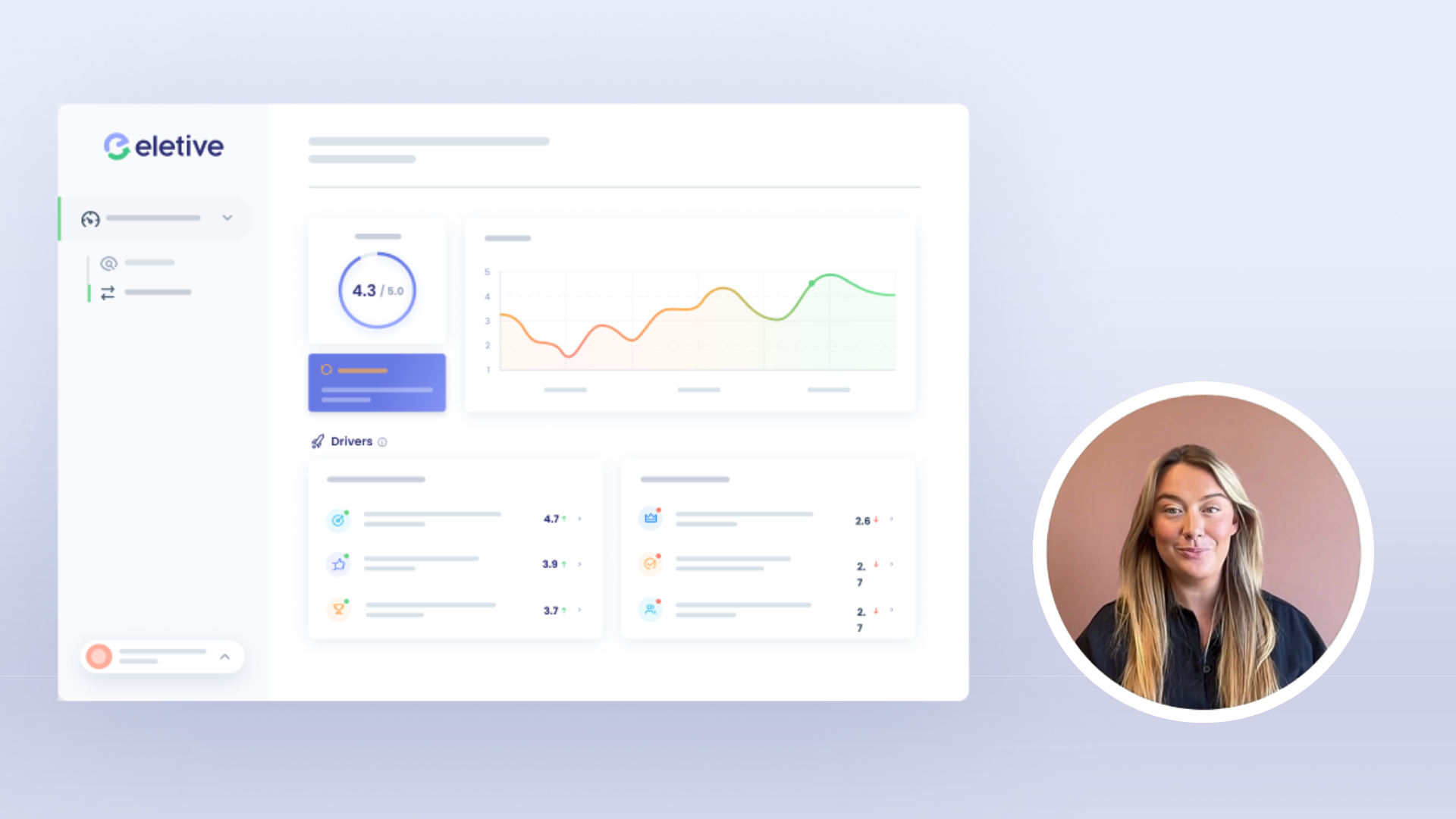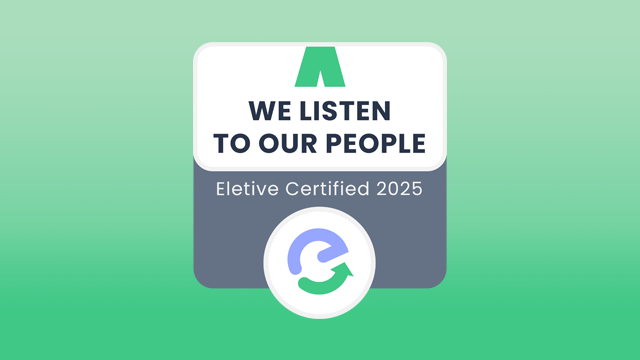Employee engagement is crucial for any organisation's success. Measuring it effectively will improve both employee well-being – and overall performance.
Employee engagement is crucial for any organisation's success, and measuring it effectively can help improve overall performance.
Developing a comprehensive engagement strategy that aligns with company values and goals while promoting work-life balance is essential though. We hope to guide you through that process in this blog post.
You'll learn how to conduct engaging surveys that provide actionable insights into the factors driving employee satisfaction, productivity, and retention.
Employee engagement definition
Employee engagement pertains to the extent of an employee's emotional attachment and investment towards their work and the organisation. It surpasses job satisfaction and mirrors the level of commitment of employees in going beyond their job requirements to contribute to the success of the organisation.
Engaged employees are highly passionate, motivated, and committed to achieving the company's goals and objectives.
It can be compared to an engine that powers a car. Just as the engine provides the necessary energy to propel the vehicle forward, employee engagement provides the necessary drive and motivation to push the organisation towards success.
Eletive Scientific Foundation:format(png)/f/288714721386412/a4e73fbe44/scientific_foundation.png)
Eletive Scientific Foundation
This report provides a broad overview of how work engagement is the key to unlocking and developing a high-performing workforce.
DownloadImportance of measuring employee engagement
Measuring employee engagement is important because it provides valuable insights into how employees feel about their jobs, the company culture, and their overall well-being.
Cost of not doing it
When companies fail to measure employee engagement, they run the risk of losing valuable employees to turnover. High employee turnover is costly, as it results in increased recruitment and training costs, decreased productivity, and a negative impact on company culture.
Additionally, disengaged employees are less likely to be innovative, less productive, and less invested in the success of the company. This can lead to decreased revenue and profits over time.
Upside of doing it well
On the other hand, when companies measure employee engagement and take steps to improve it, they stand to gain many benefits.
Engaged employees are more likely to stay with the company, be more productive, and provide better customer service. They are also more likely to be innovative, come up with new ideas, and take ownership of their work.
Engaged employees have a positive impact on company culture, which can attract top talent and lead to a more successful business overall.
It’s important to note that measuring employee engagement is not a one-time event but rather an ongoing process. Which is why we encourage regular pulse surveys.
Focus groups, and other forms of feedback can also help companies stay in touch with employee sentiment and make adjustments as needed.
What are the best metrics for measuring employee engagement? 9 key metrics to track
1. Employee net promoter score (eNPS)
The eNPS is a metric that measures employee loyalty and satisfaction by asking employees how likely they are to recommend their company as a place to work.
This metric is important because it provides insight into how engaged employees are and how likely they are to stay with the company. eNPS is measured by asking a single question: ”How likely is it that you would recommend your employer to a friend or acquaintance?” The answer options range from 0 to 10, where 10 means “Extremely likely” and 0 means “Not at all likely”. The responses are then divided into Promoters (9, 10), Passives (7,8), and Detractors (0-6).
2. Employee satisfaction index
The Employee Satisfaction Index measures how satisfied employees are with their jobs, coworkers, and company culture. This metric is important because it provides insight into how engaged and motivated employees are, as well as their overall well-being. Companies track this metric by regularly surveying employees and asking them to rate their satisfaction and engagementon a scale. At Eletive we call this the Employee Engagement Index.
3. Employee effort score (EES)
The EES measures the level of effort required by employees to get their jobs done. This metric is important because it provides insight into how efficient and effective the company's processes and systems are, as well as the level of support provided to employees.
Companies track EES by asking employees to rate the level of effort required to complete a specific task or project. You can do this in Eletive using a custom survey.
4. Employee retention rate
The Employee Retention Rate measures the percentage of employees who stay with the company over a given period of time. This metric is important because it provides insight into how well the company is retaining talent and whether employees are happy and engaged. Companies track this metric by calculating the percentage of employees who remain employed over a set period, such as a year.
It’s very valuable for employers to do cross-analysis and see how the retention rate correlates with engagement rates. Doing so over time allows them to use employee engagement for predictive analytics and a leading KPI for retention.
5. Employee turnover rate
The Employee Turnover Rate measures the percentage of employees who leave the company over a given period of time. This metric is important because it provides insight into the company's ability to retain talent and the overall job satisfaction of employees. Companies track this metric by calculating the percentage of employees who leave the company over a set period, such as a year.
6. Absenteeism rate
The Absenteeism Rate measures the percentage of scheduled work time that employees miss due to absences, such as sick days or vacation. This metric is important because it provides insight into employee well-being and job satisfaction, as well as the impact of absences on productivity. Companies track this metric by calculating the percentage of scheduled work time that is missed due to absences.
7. Employee productivity
Employee Productivity measures the amount of work completed by employees over a given period of time. This metric is important because it provides insight into the company's efficiency and the effectiveness of its processes and systems. Companies track this metric by measuring the amount of work completed by employees over a set period of time.
8. Employee recognition rate
The Employee Recognition Rate measures the percentage of employees who receive recognition for their work. This metric is important because it provides insight into the company's culture of appreciation and the level of engagement and motivation of employees. 40% of employees report receiving recognition just a few times a year or even less, which is not enough to maintain high engagement levels.
9. Diversity and inclusion index
The Diversity and Inclusion Index measures the level of diversity and inclusivity within the company.
Eletive allows you to measure the impact of your diversity initiatives easily because we offer a specific question battery. Ensuring that you can monitor and increase diversity and inclusion throughout the whole employee lifecycle.
Diversity and inclusion:format(png)/f/288714721386412/1785037ae6/diversity_and_inclusion.png)
5 steps: how to measure employee engagement effectively
1. Identify employee engagement metrics
It’s important to identify the metrics that are most relevant to your organisation, as well as those that will provide meaningful insight into employee performance and satisfaction.
The first step in determining which metrics to measure is to assess the current state of employee engagement within your organisation. This can be done by conducting surveys or focus groups with employees, asking them questions about their job satisfaction and commitment levels. Furthermore, it may be beneficial to examine external data points such as industry averages or customer feedback surveys for comparison.
Once you have a good grasp of your company's employee engagement levels, it is time to begin monitoring progress with relevant metrics.
In the Eletive platform, we focus on 11 different aspects of the employee experience.
Feedback and communication
Autonomy
Meaningfulness and participation
Workload
Health
Workplace and tools
Learning and development
Goals and goal achievement
Strategy, vision, and culture
Relationship with manager
Relationships with colleagues
Whatever metrics you choose, it’s essential to keep track of them. Assess your metrics on a consistent basis so that any modifications taken in response to the data will actually be effective for both workers and employers. Doing so will help ensure that any changes made based on insights gained from these numbers will actually result in improved outcomes for both employees and employers alike.
Moving on to the next step in improving employee performance, analysing performance data is key to unlocking insights into what drives productivity.
2. Analyse performance data
This involves looking at trends over time as well as comparing different departments or teams within your organisation. For example, if one team consistently outperforms another then this could indicate a lack of resources or training in the lower performing group.
Eletive’s regular and intelligent pulse surveys can be used here too. They allow you to get direct feedback about what’s working (or not) for employees in their current role(s).
By utilising an automated system to gather employee feedback, you can save a considerable amount of time on administrative tasks. With just a few clicks on your dashboard, you can easily access real-time data on your employees' satisfaction and pinpoint areas that require your attention.
This streamlined approach allows you to minimise your administrative workload and dedicate more time to the important work that truly makes a difference.
Examining the data will give you a sharper understanding of which approaches are most successful in heightening staff engagement and augmenting performance across all levels.
3. Develop engagement strategies
HR managers should create specific strategies designed to improve employee engagement and performance levels based on the data.
These might include initiatives such as providing incentives for high-performing employees, offering flexible working hours, creating a positive work environment with recognition programs, or implementing professional development opportunities like mentorship programs or skills training courses.
It's also important for organisations to provide feedback on progress made against goals so employees can see their accomplishments being recognized.
HR managers should then monitor progress against these strategies over time using the same metrics used initially to measure employee engagement levels. They should be able to track changes in absenteeism rates or turnover rates and compare them with previous periods of time when no interventions were implemented in order to gauge whether their efforts have been successful at improving employee engagement and performance levels overall.
To ensure they remain on the path to success, organisations should review their progress regularly - either annually or semi-annually.
4. Monitor progress
It is imperative to monitor the same indicators over time in order to guarantee exactness of outcomes, so that any modifications in performance can be recognized promptly.
Regularly checking-in with employees is also essential for keeping tabs on how they're feeling about their work environment and if any issues need addressing. Feedback from supervisors can help HR managers identify areas where further improvement may be needed.
By implementing processes such as regular reviews of key performance indicators (KPIs), benchmarking against industry standards, or comparing current results to historical trends, HR managers can gain insights into how well their initiatives are working and make adjustments accordingly if necessary.
Having a system in place for tracking progress will enable teams to stay informed of developments within the organisation and recognize when certain strategies may not be delivering desired outcomes so appropriate action can be taken promptly.
5. Evaluate results
Once the strategies have been put into practice, it is essential to assess their efficacy. HR managers should track employee engagement metrics and performance data over time to determine if the strategies are having a positive impact on employee engagement and productivity.
After the assessment of the strategies' efficacy, any necessary alterations should be made to ensure optimal effectiveness.
For example, if an organisation has implemented a new incentive program that rewards employees for meeting certain goals, they should measure how successful it is at motivating employees by tracking key performance indicators such as customer satisfaction ratings or sales figures. If these metrics show improvement after implementing the incentive program, then it can be assumed that the strategy was effective and could be continued with slight modifications based on further analysis of results.
In the event that no noteworthy shift in execution markers is seen after executing a particular methodology, extra activities may need to be embraced so as to build representative inspiration and commitment levels.
It’s also important for HR managers to pay attention not only to quantitative data but also qualitative feedback from employees about their experience with different initiatives or programs put into place by management. This type of information can provide valuable insight into what works best for your team and what needs more tweaking before being rolled out company-wide.
Eletive surveys have options for different types of questions, to capture as valuable insights as possible. This includes closed-ended questions, open-ended questions, eNPS surveys, anonymous chat and whistleblower channel. Together, these channels provide both qualitative and quantitative insights.
Moreover, our AI feature (Listening AI) allows organisations to interpret large data sets from open-ended questions.
Employee engagement case studies
SATS
Gym training SATS:format(jpeg)/f/288714721386412/520ec1b159/sats.jpg)
SATS, a Nordic fitness chain, implemented Eletive to measure employee engagement in real-time and enable self-leadership.
We needed a more modern way of working with employee engagement surveys, and we wanted to enable self-leadership at all levels of the organisation.
The implementation of Eletive has led to a more unified and proactive approach to employee engagement and well-being.
Mekonomen
Women shopping Mekonomen:format(jpeg)/f/288714721386412/da70f78185/mekonomen.jpg)
Mekonomen Group, a leading automotive spare parts chain in northern Europe, replaced their old employee engagement survey system with Eletive's agile pulse surveys. The previous method of one massive survey every two years was tedious and lacked relevancy due to the delay in results.
We went from one survey every other year, to agile realtime pulse surveys
With Eletive, Mekonomen Group has a user-friendly platform that gathers everything related to employee engagement and experience, enabling them to send several smaller pulse surveys and at least one larger survey every year.
They can now get real-time insights, which allows for faster action and improvements.
Related reading: Real-time pulse surveys vs. annual employee engagement surveys | Eletive
Employee engagement measurement tools
When it comes to employee engagement measurement tools, there are various options available in the market. It can be difficult to choose a vendor. However, when it comes to the "best" tool for measuring employee engagement Eletive stands head-and-shoulders above the rest in our opinion.
Why?
Eletive is a highly intuitive and powerful People Success Platform that enables fast and flexible pulse surveys, offering immediate insights into employee engagement and experience. Our strength lies in the unique focus on self-leadership, and empowering every individual at every level of the organisaiton. This makes it a compelling choice for any organisation seeking to assess and enhance employee engagement and performance.
:format(png)/f/288714721386412/8bc74e1c86/ewebinar__1_.png)
Increase engagement with Eletive
We'd love to guide you through our platform – book a no-obligation demo to see Eletive in action!

Johanna is Content Manager at Eletive, where she juggles everything from blogging and social media to webinars and customer communications. She enjoys using digital marketing strategy and creative content marketing to help organisations build workplaces where people thrive.

























:format(jpeg)/f/288714721386412/587a7584e4/blog-measure-employee-engagement-hero_media.jpg)
:format(png)/f/288714721386412/70a5012076/blog-eletive-secures-growth-investment-from-accel-kkr-hero_media.png)
:format(jpeg)/f/288714721386412/a906f14dff/blog-hr-trends-2026-ai-data-and-employee-experience-hero_media.jpg)
:format(png)/f/288714721386412/9f8e0a2347/blog-beyond-the-hype-the-new-rules-of-people-success-in-a-global-ai-powered-hero_media.png)